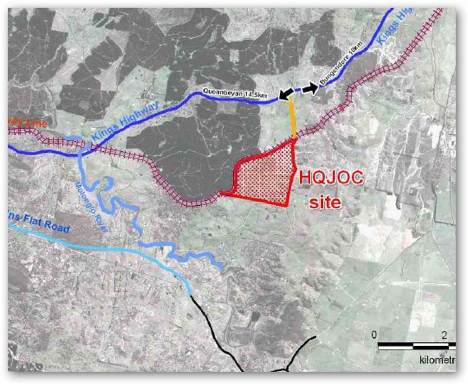It’s been a few months since we’ve had a Google Earth censorship “eruption” so we were definitely overdue the one now underway near Canberra. As usual, the blame lies with the media.
Defence Headquarters Joint Operations Command wiped from Google Earth, begins the article in Australia’s Daily Telegraph and reprinted in local papers like Adelaide Now and the Herald Sun. You’d be forgiven for thinking that the buildings in question once were visible on Google Earth but now no longer. You’d be wrong. They never have been, and not because of censorship. Insinuates the article:
Google Earth’s images of the surrounding area were taken in 2008, but the Bungendore site itself is represented only by an image taken before October, 2006, when John Howard turned the first sod.
Actually, the region to the East of Canberra where the new HQ lies is a hodgepodge of different imagery. Canberra itself has some fine new aerial imagery from March 2008. Move East, however, and you get DigitalGlobe satellite imagery from October 2006. The region of the HQ is DigitalGlobe imagery from May 2005. Just to the South and East of it is DigitalGlobe imagery from October 2004. (You can tell by zooming in on the imagery and looking at the status bar at the bottom of the screen.)
Much as we’d all like to have the most recent imagery everywhere, that’s just not the case. And when sensitive areas fail to be covered by the very latest imagery out there, that does not constitute censorship. And that is the point the Google spokesperson tries to make to the reporter:
A Google spokesman said Defence had not insisted on the image’s removal, but it was “not unusual” for old images to be used if they had better resolution than fresh shots.
Imagine that, an outright denial from Google, and it just gets ignored because it gets in the way of a good story. And even if Defence had asked Google, Google wouldn’t have been under any obligation to help: A state’s jurisdiction does not extend into space, so no country’s government has a say over satellite imagery. (And no doubt that is why Australia didn’t bother asking.) Had the imagery been aerial, then Defence would have had the authority, but then it would have had to censor the imagery itself before releasing it to the public. That clearly didn’t happen here, as Google Earth’s attribution to DigitalGlobe shows.
BTW, here is the spot in question. Le Technoblog du LAC has the intel on the precise location of the new HQ:

And here it is on Google Maps/Earth:
Using the DG layer to determine the date of an image has always been a problem for me. Take this location as an example. Stefan says that if I zoom in close, I’ll see the provider/date on the status bar at the bottom of the screen. When I zoom in close anywhere on the property, I get:
“Image c 2008 digital Globe.
c 2008 MapData Sciences PtyLtd, PSMA”.
If I keep my eye altitude at 10,000ft. and travel east, I see no change until about 7 miles out, where a 3rd line, saying “c 2008 Cnes/Spot Imag” appears. Zoom in to 8000ft. and it disappears. I assume that at the higher altitude my GE image window included a piece of that 3rd provider’s image.
Now to the DG layer. I click each layer in turn and find that the site is covered by DG images:
– 2008-02-20 0-10pct. cloud cover
– 2008-01-20 51+
– 2007-10-17 0-10
– 2005-05-15 0-10
– 2005-03-04 11-50
– 2004-06-07 0-10
– 2004-04-24 11-50
– 2004-05-12 51+ (I think. there’s overlap)
– 2003-04-22 0-10
– 2003-08-02 11-50
– 2003-06-27 51+
– 2002-12-04 0-10
– 2002-08-13 11-50
– 2002-11-29 51+
Each rectangle showing the coverage of a single image has a “DG” icon at its center. Click on the icon and then click on “Preview” in the popup window and you’ll see the image that was taken by DG. The DG “clear” images (1-10pct cloud cover) for 2008 and 2007 show activity on the property. The 2005 image does not. Stefan says that the imagery shown in GE is a 2005 image from DG. I can sort of see that by checking the original images, but how does Stefan do it? Stefan says “(You can tell by zooming in on the imagery and looking at the status bar at the bottom of the screen.)”, but nothing shows up in the status bar for me. The copyright info appears in the GE image window itself, and says nothing about 2005.
Stefan, can you enlighten me (us)?
Thanks,
Ernie
I thought I’d check to see if Google Maps showed something different than Google Earth. Zooming all the way in with Google Maps gives me:
“c 2008 Google – Imager c2008 DigitalGlobe, GeoEye, map Data c2008 mapData Sciences Pty Ltd, PSMA”
This is pretty much the same info as GE gives me. Note that Stefan’s embedded Google Map also includes “Cnes/Spot Image” in the attribution line. I think that’s because he’s zoomed further out and his view includes more image providers’ imagery.
Speaking of Spot Image, I forgot to check their coverage. Spot Image has an image covering the site from 2007-11-27. That’s the “Cnes/Spot Image” image.
Ernie
You have to be using the latest version of the Google Earth client (4.3) to see the date of the image, which is different from the copyright date.
Zooming in on the location, it does say “May 15, 2005”
OK, I see it now. The date, “May 15, 2005”, does appear in the status bar, between the terrain elevation, in the center, and the eye altitude, on the right. I’m surprised that I missed it. Thanks.
Ernie